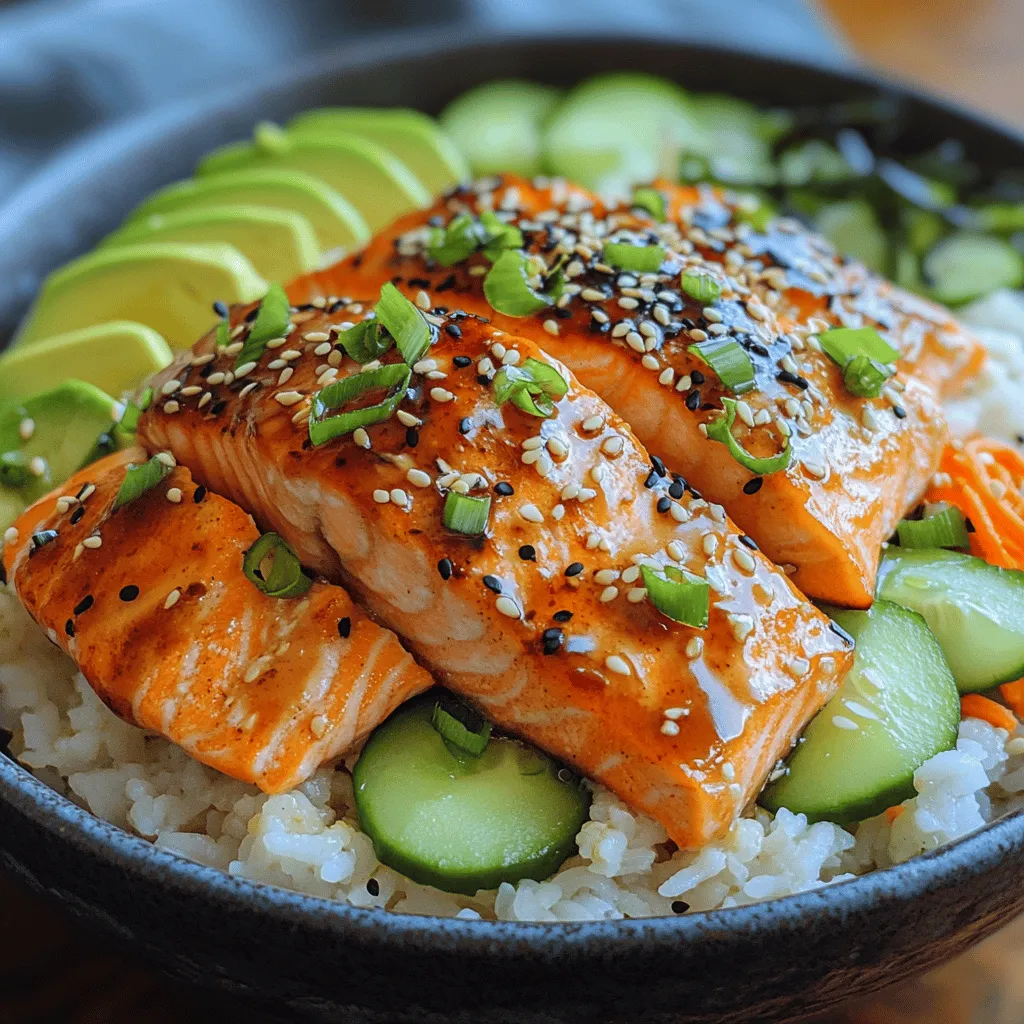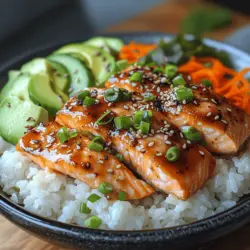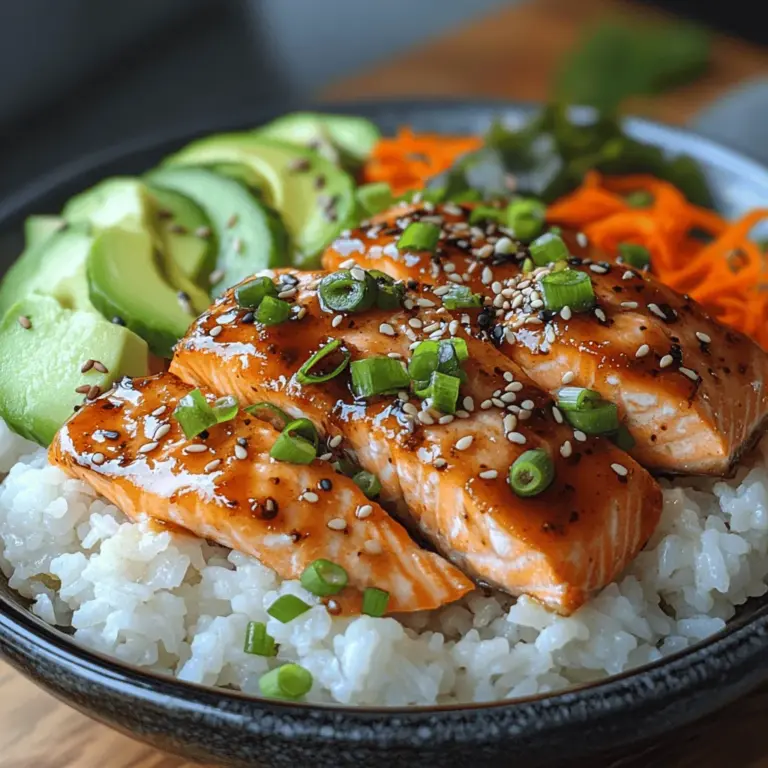Introduction
Salmon has long held a celebrated position in culinary traditions around the world, valued not only for its rich flavor but also for its numerous health benefits. As a versatile protein, it gracefully adapts to a myriad of preparations, becoming the star of many dishes—from simple grilled fillets to more intricate recipes. One dish that has gained immense popularity in recent years is the Savory Miso Glazed Salmon Rice Bowl. This delightful meal encapsulates the heart of Japanese cuisine while delivering a healthy and satisfying option for any occasion.
The Savory Miso Glazed Salmon Rice Bowl is not just a feast for the taste buds; it offers a harmonious balance of flavors and textures. The umami-rich miso glaze complements the tender, flaky salmon, while the nutty undertones of rice serve as a perfect base. Fresh vegetables add a delightful crunch, contrasting beautifully with the buttery salmon, making each bite an adventure. This dish’s versatility allows it to shine at various settings—be it a casual weeknight dinner, an impressive meal for guests, or a convenient option for meal prep. This recipe is adaptable, allowing for a personal touch depending on dietary preferences or seasonal ingredients.
Understanding the Ingredients
To master the Savory Miso Glazed Salmon Rice Bowl, it’s essential to understand its key components and their nutritional benefits. Each ingredient plays a vital role, contributing not only to the dish’s flavor profile but also enhancing its healthfulness.
Salmon
At the heart of this bowl is salmon, a superfood that boasts a wealth of nutritional benefits. Rich in omega-3 fatty acids, salmon supports heart health, reduces inflammation, and promotes brain function. Furthermore, it is an excellent source of high-quality protein, essential for muscle repair and growth. The omega-3s found in salmon are particularly important for maintaining a healthy balance of fats in our diet, making it a fantastic choice for those looking to improve their overall well-being.
Miso Paste
Miso paste is a fermented soybean product that brings a unique depth of flavor to this dish. It is high in probiotics, which are beneficial for gut health and digestion. Miso adds a distinctive umami flavor, enhancing the overall taste of the salmon while also providing a creamy texture to the glaze. This ingredient is not only flavorful but also aligns with health-conscious eating, as it is low in calories and rich in vitamins and minerals.
Honey or Maple Syrup
To achieve the perfect balance of savory and sweet in the glaze, honey or maple syrup is used as a natural sweetener. Both options offer health benefits: honey is known for its antioxidant properties and potential antibacterial effects, while maple syrup contains minerals such as manganese and zinc. These natural sweeteners help to round out the flavors in the marinade, creating a delectable glaze that caramelizes beautifully during cooking.
Soy Sauce
Soy sauce is another key ingredient in this recipe, adding a savory depth that complements the fish. It enhances the umami profile of the dish, making it more satisfying. For those watching their sodium intake, low-sodium soy sauce alternatives are readily available, ensuring everyone can enjoy this dish without compromising their dietary needs.
Rice
The base of the bowl is rice, which provides essential carbohydrates for energy. Whether you choose white, brown, or even cauliflower rice for a lower-carb option, rice serves as a perfect canvas for the vibrant flavors of the salmon and vegetables. It also helps to soak up the delicious miso glaze, making each bite a flavorful experience.
Vegetables
Fresh vegetables like avocado, cucumber, and carrots offer a burst of color and nutrition. Avocado is rich in healthy fats, fiber, and vitamins, while cucumber adds a refreshing crunch. Carrots, being high in beta-carotene, contribute to eye health and provide a natural sweetness. Together, these vegetables not only elevate the dish’s visual appeal but also enhance its nutritional profile.
The Art of Marinating Salmon
Marinating salmon is a crucial step in enhancing its flavor and ensuring a juicy, succulent result. The process of marination allows the fish to absorb the savory notes of the miso glaze, making every bite a burst of flavor.
Step-by-Step Guide to Preparing the Marinade
1. Gather Your Ingredients: Start by gathering miso paste, soy sauce, honey or maple syrup, and any additional flavor-enhancers you prefer, such as ginger or garlic.
2. Mix the Marinade: In a bowl, combine 3 tablespoons of miso paste, 2 tablespoons of soy sauce, and 1 tablespoon of honey or maple syrup. Whisk together until smooth. You can also add minced garlic or ginger for an extra layer of flavor if desired.
3. Taste and Adjust: Taste the marinade and adjust according to your preference. If you like it sweeter, add more honey or maple syrup; if you crave more umami, a splash of soy sauce will do the trick.
4. Marinate the Salmon: Place the salmon fillets in a shallow dish or a resealable plastic bag and pour the marinade over them. Ensure that the salmon is well-coated in the mixture. For optimum flavor, marinate for at least 30 minutes; however, for deeper flavor absorption, marinate for 1 to 2 hours in the refrigerator.
Balancing Salty and Sweet Flavors
The key to a successful marinade lies in achieving a balance between salty and sweet flavors. Miso and soy sauce contribute saltiness, while honey or maple syrup adds sweetness. This balance enhances the natural flavors of the salmon and creates a rich, satisfying glaze once cooked.
Tips for Adjusting the Marinade to Personal Taste
– Add Spice: If you enjoy a kick of heat, consider adding a pinch of red pepper flakes or a dash of sriracha to the marinade.
– Herbs and Zest: Fresh herbs like cilantro or scallions can be mixed into the marinade for added freshness. Additionally, a touch of citrus zest (such as lemon or lime) can brighten the flavors.
Recommended Marination Times for Optimal Flavor Absorption
– 30 Minutes: This minimum time allows the salmon to absorb some of the flavors but will not be as intense.
– 1-2 Hours: Ideal for infusing the fish with flavor while still maintaining its delicate texture.
– Overnight: For an exceptionally flavorful result, marinating overnight is recommended, but be cautious, as too much time can lead to a strong flavor that may overpower the salmon.
Cooking Methods for Perfect Salmon
Once your salmon is marinated, the next step is cooking it to perfection. There are several methods to choose from, each offering its own benefits and resulting in different textures and flavors.
Overview of Different Cooking Methods: Grilling vs. Baking
1. Grilling: Grilling salmon can impart a wonderful smoky flavor and create beautiful grill marks. The high heat caramelizes the sugars in the marinade, resulting in a delicious crust. However, grilling requires careful attention to prevent overcooking.
2. Baking: Baking salmon is an easier method for beginners and ensures even cooking throughout the fillet. It allows for more consistent results without the need for constant monitoring, making it an excellent choice for meal prep or larger batches.
Pros and Cons of Grilling
– Pros:
– Adds a smoky flavor and appealing grill marks.
– Quick cooking time.
– Cons:
– Requires careful attention to prevent overcooking.
– May not be suitable for all kitchens, especially those without outdoor grills.
Benefits of Baking for Ease and Consistency
– Easy to Prepare: Simply place the salmon on a baking sheet, pour the marinade over it, and let the oven do the work.
– Consistent Results: Baking at a controlled temperature ensures even cooking and reduces the risk of drying out the fish.
Tips for Achieving the Ideal Texture and Doneness
– Use a Meat Thermometer: The ideal internal temperature for cooked salmon is 145°F (63°C). Using a meat thermometer ensures that your salmon is perfectly cooked and safe to eat without being overdone.
– Check for Flakiness: Salmon is done when it flakes easily with a fork. If it appears opaque and separates easily, it is ready to serve.
Signs of Perfectly Cooked Salmon
– Color: Perfectly cooked salmon should have a vibrant pink color in the center, which will fade slightly as it cooks.
– Texture: If the salmon flakes easily with a fork and the flesh is opaque, it is a sign that it is cooked through but still moist.
– Moisture: The salmon should be moist and tender, not dry or overly flaky.
As you embark on preparing your Savory Miso Glazed Salmon Rice Bowl, these foundational steps will guide you in creating a deliciously satisfying meal. Stay tuned for the next section, where we will delve deeper into assembling this vibrant bowl and explore serving suggestions that will elevate your dining experience.

Suggestions for Using a Meat Thermometer
When preparing your Savory Miso Glazed Salmon Rice Bowl, achieving the perfect doneness for your salmon is crucial. One of the best tools for this task is a meat thermometer. It ensures that your fish is cooked safely while retaining its moistness and flavor. Insert the thermometer into the thickest part of the salmon fillet. The ideal internal temperature for perfectly cooked salmon is around 125°F (51°C) for medium-rare, or 145°F (63°C) for medium to well-done. Keep in mind that the salmon will continue to cook slightly after being removed from the heat, so you may want to take it off the stove a few degrees shy of your target temperature.
Building Your Rice Bowl
The Foundation: Choosing and Preparing the Right Rice
The rice is the cornerstone of your Savory Miso Glazed Salmon Rice Bowl. Selecting the right type of rice is essential for achieving the desired flavor and texture. For this dish, sushi rice or jasmine rice are excellent choices, as they both complement the savory miso glaze and salmon beautifully.
Cooking Tips for Perfect Rice Texture: Rinse the rice under cold water until the water runs clear to remove excess starch; this helps to prevent the rice from becoming too sticky. For sushi rice, use a ratio of 1 cup of rice to 1.2 cups of water, and let it soak for about 30 minutes before cooking. If you opt for jasmine rice, a simple 1:1.5 ratio of rice to water works well. Allow the rice to rest for 10 minutes after cooking, covered, to ensure that it steams and finishes cooking evenly.
Layering the Ingredients for Optimal Flavor and Presentation
Once your rice is perfectly cooked, it’s time to layer the ingredients in your bowl. Start by placing a generous serving of rice at the bottom, creating a solid foundation. Next, artfully arrange the salmon on top of the rice, allowing the miso glaze to cascade down the sides for an inviting look.
Importance of Color and Texture in the Bowl: To enhance the visual appeal, incorporate a variety of colors and textures. Bright green vegetables, such as snap peas or steamed broccoli, can contrast beautifully with the pink salmon. Additionally, the creaminess of avocado slices or the crunch of radishes can add depth to the dish.
Creative Ways to Arrange the Toppings for Visual Appeal
To elevate your rice bowl’s presentation, think beyond simple layering. Consider using the “rainbow” technique, where you arrange toppings in a gradient of colors. For instance, place the salmon in the center, followed by a row of vibrant vegetables, and finish with a sprinkle of sesame seeds and herbs. This not only pleases the eye but also encourages diners to enjoy a bite of everything in each spoonful.
Garnishing Your Rice Bowl
The Role of Garnishes in Enhancing Flavor and Presentation
Garnishes may seem like an afterthought, but they play a significant role in both flavor and presentation. A well-chosen garnish can elevate your Savory Miso Glazed Salmon Rice Bowl from ordinary to extraordinary. Fresh herbs, vibrant vegetables, and crunchy toppings can add layers of flavor and texture that enhance the overall experience.
Benefits of Green Onions and Sesame Seeds
Green onions are a classic garnish for rice bowls, providing a mild onion flavor and a pop of green that livens up the dish. Simply slice them thinly and scatter them over the salmon and rice. Similarly, sesame seeds add a nutty flavor and an appealing crunch. Toasted sesame seeds can enhance their flavor and add warmth to the dish.
Exploring the Use of Seaweed Sheets: Types and How to Prepare Them
Seaweed sheets, such as nori, can be an excellent addition to your rice bowl. They can be cut into strips and placed on top of the salmon or served alongside the bowl for dipping. Nori adds a unique umami flavor and a delightful chewy texture that complements the other ingredients. To prepare, simply cut the sheets into desired sizes and serve them either raw or lightly toasted for added crunch.
Suggestions for Additional Garnishes or Toppings for Customization
Feel free to get creative with your garnishes. Pickled ginger can add a zesty kick, while sliced cucumbers can provide a refreshing crunch. For an extra touch of flavor, consider adding a drizzle of spicy mayo or a splash of soy sauce. The beauty of a rice bowl is its versatility; you can tailor it to your personal tastes or dietary preferences.
Nutritional Aspects of the Savory Miso Glazed Salmon Rice Bowl
Analysis of the Dish’s Overall Nutritional Profile
The Savory Miso Glazed Salmon Rice Bowl is not only satisfying but also packed with nutrients. Salmon is a fantastic source of high-quality protein, omega-3 fatty acids, and essential vitamins and minerals, including vitamin D and selenium. The rice serves as a carbohydrate source, providing energy, while the addition of vegetables contributes fiber, vitamins, and antioxidants.
Balance of Macronutrients: Proteins, Fats, and Carbohydrates
A well-balanced meal should include all three macronutrients: proteins, fats, and carbohydrates. This rice bowl achieves that balance beautifully. The salmon provides healthy fats and protein, while the rice offers carbohydrates that fuel your body. The vegetables contribute additional nutrients and fiber, making this dish both filling and nutritious.
Vitamins and Minerals Found in the Ingredients
In addition to macronutrients, the ingredients in your Savory Miso Glazed Salmon Rice Bowl offer a wealth of vitamins and minerals. Salmon is rich in B vitamins, which support energy metabolism, while vegetables like broccoli and snap peas are high in vitamin C and K. The rice provides essential minerals such as magnesium, which is important for muscle and nerve function.
Discussion on the Health Benefits of a Balanced Meal
A balanced meal like this rice bowl can have numerous health benefits. Consuming a variety of food groups ensures that you receive a range of nutrients necessary for optimal health. The omega-3s found in salmon are known to support heart health, while the fiber from vegetables aids digestion. Additionally, the combination of protein and carbohydrates helps maintain stable blood sugar levels, keeping you energized throughout the day.
Serving Suggestions and Pairings
Ideas for Side Dishes or Beverages That Complement the Rice Bowl
To create a complete meal, consider serving your Savory Miso Glazed Salmon Rice Bowl with complementary side dishes. A light cucumber salad dressed with rice vinegar is a refreshing option that pairs well with the flavors of the bowl. Alternatively, a simple miso soup can enhance the umami experience while offering warmth and comfort.
Suggestions for Salads or Soups That Pair Well
For salads, opt for something light and crisp, such as a seaweed salad or a mixed greens salad dressed with sesame oil. These options provide a lovely contrast to the richness of the salmon and the starchiness of the rice. If you prefer soup, a clear broth with tofu and scallions can cleanse the palate between bites.
Beverage Options: Tea or Light Cocktails for a Complete Meal
When it comes to beverages, a cup of green tea is a classic and refreshing choice that complements the dish beautifully. If you want to elevate your meal experience, consider serving a light cocktail, such as a yuzu spritz or a sake-based drink. Both options can enhance the dining experience without overpowering the flavors of the rice bowl.
Presentation Tips for Serving at Gatherings or Special Occasions
For special occasions, presentation is key. Serve each rice bowl in a clean, colorful bowl that allows the vibrant ingredients to shine. Consider placing garnishes on top in an artistic manner, and provide chopsticks or elegant utensils to enhance the dining experience. A well-set table with decorative elements can also create a welcoming atmosphere for your guests.
Conclusion
The Savory Miso Glazed Salmon Rice Bowl is a culinary delight that brings together flavor, nutrition, and versatility. Its rich umami profile, combined with the freshness of vegetables and the comforting texture of rice, makes it a dish that appeals to a wide range of palates. By preparing this meal at home, you not only enjoy a delicious dish but also embrace the joy of cooking and sharing meals with loved ones.
We encourage you to try making this rice bowl in your kitchen, experimenting with different toppings and garnishes to make it your own. As you savor each bite, you’ll appreciate the harmony of flavors and the health benefits that come with this balanced meal. Cooking is not just about feeding the body; it’s about nourishing the soul, creating memories, and enjoying the process of bringing people together around the table.


